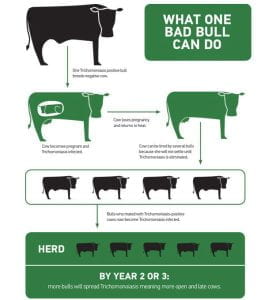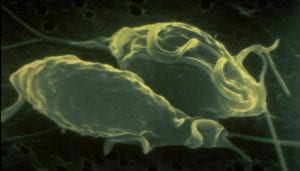The most important step is to purchase only bulls for herd sires that have tested negative.
January 25, 2023

“Reproductive failure” is an all-encompassing term if a cow loses a calf during pregnancy or if she fails to get pregnant. Causes of reproductive failure are frequently divided into infectious and non-infectious categories. Examples of “non-infectious” include poor cow nutrition (lack of energy and micronutrients such as selenium/Vitamin E); bull infertility, disease and injury; breeding season management errors (shortened breeding season, insufficient bull-to-cow ratios); genetic and some congenital abnormalities that result in fetal death; and toxic agents such as nitrates, phytoestrogens, and drugs including steroids and prostaglandins.
“Infectious” causes are bacteria, viruses, protozoal and fungal agents that directly or indirectly damage the placenta and/or the fetus. Examples include the BVD virus, IBR virus, the protozoan Neospora caninum, the bacterium Leptospira, and the venereal diseases trichomoniasis and vibriosis, among many others. This series of articles will explore the most common infectious causes of abortion and reproductive failure in cattle and available options for control and prevention.

The most common venereal diseases of cattle are trichomoniasis and vibriosis, often referred to as “trich” and “vibrio”, respectively. Bovine trichomoniasis is caused by the protozoan Tritrichomonas foetus (T. foetus) while vibriosis is caused by the bacterium Campylobacter fetus subsp. venerealis (C. fetus) Although both are infrequently diagnosed, the results of infection on reproduction can be devastating. Both trich and vibrio are transmitted through physical contact when a bull breeds a cow. Once a cow is infected, she acts as a source of infection for other non-infected bulls within the herd which then spread disease to other cows.
Infected bulls show no signs of disease, however, either pathogen in cows causes genital infection characterized by early abortions, low pregnancy rates, and prolonged calving seasons. In herds that do not check females for pregnancy, these diseases appear simply as cows coming up open that should be calving. Economic losses result due to the reduced size of the calf crop, reduced weaning weights because of late calves, and the costs associated with diagnosing, culling and replacing infected cattle. Diagnostic testing for venereal diseases is not necessarily easy or inexpensive, so prevalence and economic impact are likely underestimated. If a bull tests positive for either disease, he will most likely remain infected for life. There is no effective treatment, so the cornerstone of control is based on identifying and culling infected bulls and replacement with virgin bulls.
T. foetus, the protozoan parasite responsible for trich, lives deep within the folds of skin (crypts) on the bull’s penis and prepuce (Figure 1).

Once infected, bulls are considered infected for life and there is no effective treatment available, although young bulls (1-2 years old) can occasionally clear the infection. Older bulls, ages 5 and above, have more mucosal folds and deeper crypts than younger bulls, creating the perfect environment for persistent survival of the organism. Infected bulls show no signs of disease and semen appears normal on a breeding soundness examination (BSE) but spread of the organism to cows often results in abortions early in the first trimester.
These pregnancy losses are typically noticed as an increased number of repeat breeders, irregular heat cycles, longer calving intervals and reduced pregnancy rates. Newly infected cows may still conceive but the pregnancy is resorbed 40-70 days post-breeding. In some infected cows, the uterus may become filled with pus that can be observed on the tail of the infected cow or heifer. Affected cows can mount an immune response and clear the infection from the reproductive tract in as little as 90 days but usually 4-5 months are necessary before the cow can rebreed, conceive then carry a calf to term.
Immunity in the cow does not last and cows can be re-infected with the organism. There is no treatment for bulls infected with trich. Once diagnosed in a herd, recommendations include either culling all bulls or test and cull positive bulls and replacing them with virgin bulls that are satisfactory breeders based on breeding soundness examinations. A vaccine is available (TrichGuard® by Boehringer-Ingelheim Vetmedica) and considered a useful management tool for cows experiencing problems or at increased risk for exposure to the disease. In a herd outbreak, it is generally recommended for all females to be given two doses of the T. foetus vaccine to decrease the convalescent period. Females exposed to the bull and found open should be culled or segregated into a separate breeding group for breeding after immunity develops. Consult with your local veterinarian for vaccination recommendations and protocols tailored to your specific farm needs.
Diagnosis of trich is by identification of the organism either from a skin scraping of the penis or a sample of cervical mucus from an infected cow placed in special media (a “trich pouch”) and shipped at room temperature to a veterinary diagnostic laboratory. The UKVDL has a polymerase chain reaction (PCR) test that accurately identifies this organism. Trichomoniasis diagnosis and control are coordinated at the state, not federal, level. Therefore, each state determines cattle entry requirements, the test to be used and whether positive results are required to be reported to state officials. Most states require bulls to have either one negative PCR test or three negative cultures taken at one week intervals to be considered test negative. Bulls must have a minimum of 4 days without sexual activity before they are sampled. Some states have adopted a new, more sensitive PCR that does not require a 24-hour incubation in the “trich pouch” and must be shipped cold or frozen.
Campylobacter fetus subsp. venerealis (C. fetus), the cause of vibriosis, is also found on the skin of the prepuce and penis of bulls. As with trich, bulls do not show any signs of infection, no alteration of semen and bulls remain infected for life. Infected cows exhibit reproductive failure, irregular heat cycles, and embryonic or fetal death. The cow may remain infertile for 3-5 months before immunity develops. However, a major difference from trich is that there are effective vaccines for use in cows and bulls available against vibriosis, typically denoted by a “V” in the name of the vaccine. Consistent use according to label directions provides strong protection against genital infection.
Testing for vibrio usually involves the collection and culture of a sample scraped from the sheath of a bull or vaginal fluids from a suspect cow. The bacterium responsible for vibrio is very temperature sensitive and commonly dies on the way to the diagnostic laboratory if transport of more than 24 hours is required. PCR tests have been developed and while not perfect, they are a vast improvement over previous diagnostic methods. Testing for vibriosis is only recommended for investigating poor reproductive performance when other causes have been ruled out.
Appropriate management of the breeding herd helps prevent introduction of venereal diseases. The most important step is to purchase only virgin or test negative bulls for herd sires and virgin heifers as replacements. Additional recommendations include:
• Maintain as young a bull battery as possible as older bulls are more likely to develop chronic infections;
• Do not borrow, rent, lease or buy untested bulls that have been used for breeding (see Figure 2). Test non-virgin bulls at least once by PCR before introducing them into the herd;
• For routine screening of larger bull batteries with a low risk of disease, many labs offer PCR on pooled samples of up to 5 bulls on one test;
• Breed purchased cows and heifers in a separate herd for at least one season;
• Control animal movement between farms by maintaining good fences to prevent infected bulls from mixing with uninfected animals;
• Utilize artificial insemination, when possible, to eliminate the risk of sexually transmitted diseases as well as improve the genetics of the calves;
• Cull all open cows and heifers and strongly consider culling those that conceived late in the breeding season; culture any cows with pus in the uterus found during pregnancy examination;
• Submit all aborted fetuses and placental tissue to a veterinary diagnostic laboratory for determination of the cause of any reproductive failure.;
• A short, controlled breeding season and good records help identify a breeding problem quickly.
Reproductive failure can result from a wide variety of infectious and non-infectious causes. A sound herd health program, developed with your veterinarian, will help minimize the risk of this failure and the associated economic loss.
Source: University of Kentucky
You May Also Like



